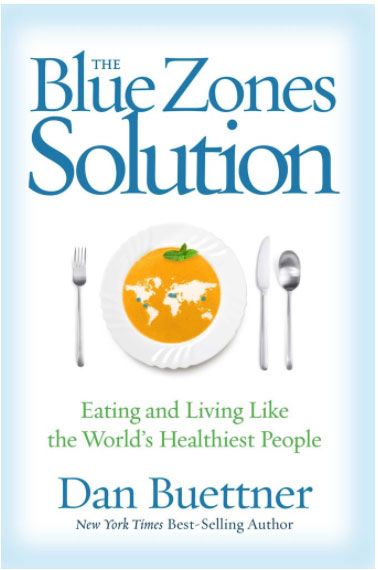
The Blue Zones Solution by Dan Buettner from National Geographic was one of my favorite health books from last year. Dan's research reveals how the world's longest-lived people actually live their lives. It's all about adding life to years, not just years to life.
For more than ten years, Dan has been researching the Blue Zones around the world. The Blue Zones are longevity "hot spots" - where there are not only the highest concentrations of people living over 100 years, but also that these people grow old without the typical chronic diseases of heart problems, obesity, cancer or diabetes. And they prosper in the most meaningful ways.
The phrase 'blue zones' came purely from researchers circling these areas on a map with blue ink!
Where are the Blue Zones?
In 2009, Dan identified five places that were Blue Zones:
- Ikaria, Greece
- Okinawa, Japan
- Ogliastra region, Sardinia
- Loma Linda, California and
- Nicoya Peninsula, Costa Rica
Dan and his team spent considerable time studying each of these areas in order to characterize their lifestyle, behaviors, culture, and environment to see what, if anything, they had in common. He listened to the stories of the centenarians, watched them as they cooked, and ate with them. The book then details the lessons can we learn from these zones.
What are the differences and what are the commonalities between these populations?
The result is that there is NOT one very specific "right" way for living and eating. Rather, we find out that there are variations on a theme that produce amazing outcomes among diverse populations. Dan pulls all the data together to show us how to create a pleasurable long healthy life that we can share with people we love.
Yes, this shows us that one size doesn't fit all - but certain common themes can work for us all. Nine commonalities were identified from the five Blue Zones that have a powerful effect on longevity and health. These are known as the Power Nine.
Power Nine
The commonalities found in diet and lifestyle among the Blue Zones turned out to be nine lessons. These are:
- Move naturally - you don't need a gym, instead the Blue Zones populations live in environments that get them moving. They have gardens in which they work; they walk to work or a friend's house.
- Purpose - this boils down to "why I wake up in the morning." All Blue Zones people have something to live for beyond just work. A sense of purpose.
- Down shift - yes Blue Zone people have stress - but they also have routines to de-stress, such as taking the time to pray, taking a nap, or having a social hour with a glass of wine and friends.
- 80% rule - In Okinawa, this is called Hara Hachi Bu - which is a reminder to stop eating when you are 80% full. Blue Zones people eat their smallest meal in the late afternoon and evening and then don't eat until the next day. They breakfast like a king, lunch like a prince, and dinner like a pauper.
- Plant slant - most of the diet is composed of plants. The Blue Zones favor beans, greens, sweet potatoes, fruits, nuts, seeds and whole grains. While 4/5 of the Blue Zones eat meat, they do so sparingly, using it as a celebratory food or a way to flavor dishes. They eat meat (mostly pork) on average five times a month.
- Wine @ 5 - people in the Blue Zones drink alcohol moderately and regularly. Moderate drinkers tend to outlive nondrinkers. They tend to have one to two glasses per day, with friends/family. It is part of socialization.
- Belong - the vast majority of Blue Zones people belong to a faith-based community. Denomination doesn't matter.
- Loved ones first - Centenarians put their families first. They keep aging family nearby, commit to a life partner, and invest time and love with their children.
- Right tribe - The Blue Zones people choose social circles to support their health behaviors. The Okinawans create moais - groups of 5 friends that commit to each other for life.
How does this apply to me?
Now that these Power Nine have been identified, Dan guides us in how to create where we live into a Blue Zone. He offers examples of new Blue Zones that have been created in Finland, Minnesota, Los Angeles, and the state of Iowa.
He talks not only of diet changes and lifestyle changes we can make as individuals and in our homes, but how we can change our community and get others involved too.
Finally the book gives us 77 Blue Zones recipes focusing on the commonalities of the different diets.
This book is 336 pages.
To find out more check the Blue Zones website where you’ll also find his TED talk and a three minute "true vitality test", which gives you a guide to your longevity based on the Blue Zones findings. Dan has three different Blue Zone books – but I like the Blue Zones Solutions one the best - as it is his most up to date research. It is definitely worth a read. Buy two and give one to a friend/family member.
Review by Ruth Baillie, CALMERme.com

